#4 square logic it solutions
Explore tagged Tumblr posts
Text
SIMDEW VALLEY SET 🍄👩🏿🌾🐷🐴🐄🧙🏿♂️🌻🌽
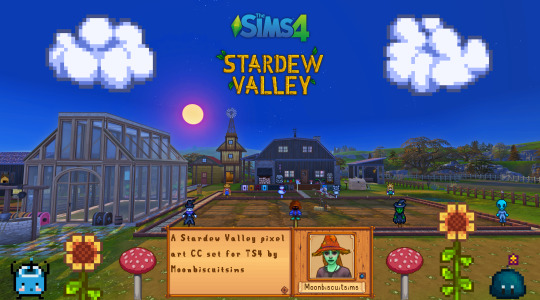
Stardew Valley Pixel Art Floors/Walls/Deco (TS4) Download Below
Aside from a couple most of these pics are just the demo pics showing what's included, more CC in game pics can be seen here
🍄Misc Large Decals




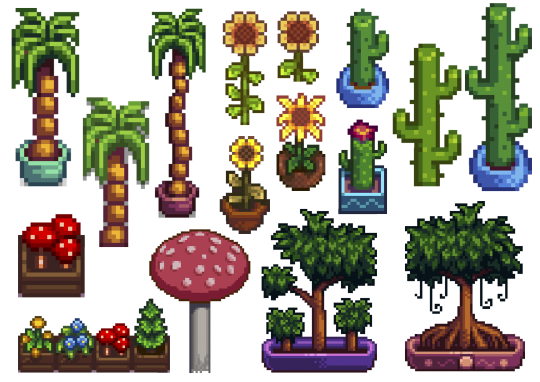
In order: Junimo huts + large Junimos, Holdiay Decor and "sky decor", furniture items, rarecrows, plants.
🍄Wall Decals Paintings and Banners:
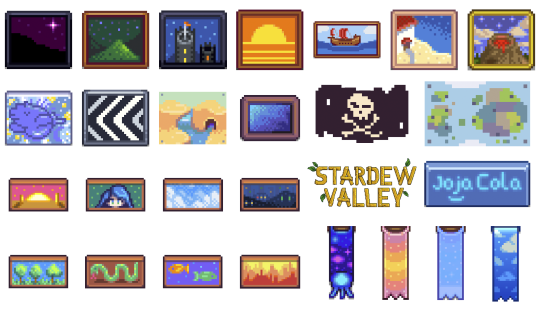
🍄Wall Decals Misc small:
Adventure stuff and boots, small junimos, random furniture items slime monsters different expressions
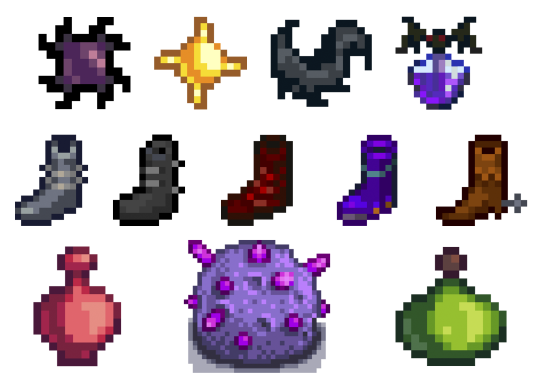
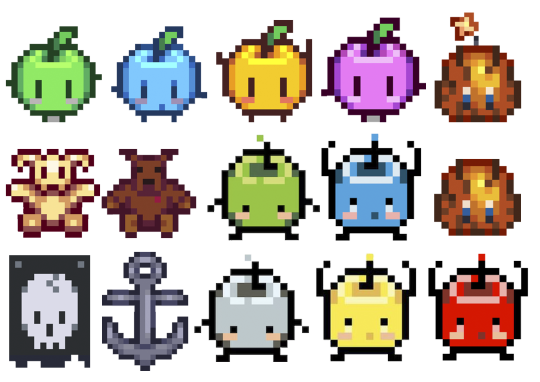

🍄Wall decals Gems and Minerals:
I didn't do them all, just some that I liked.
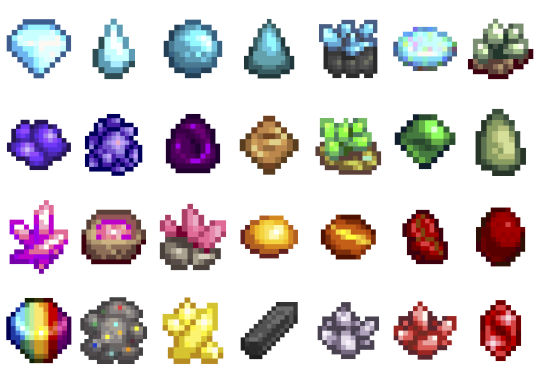
🍄Wall decals farm animals
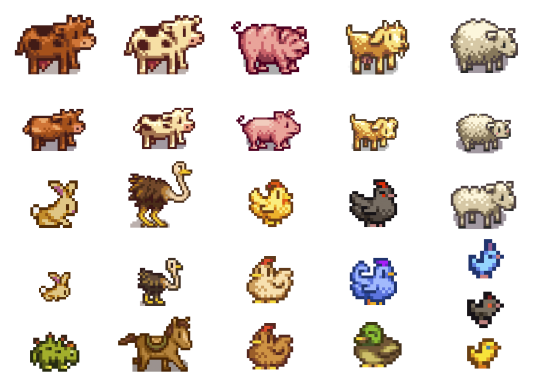
🍄Wall decals Fishing
Again just the fish I wanted to do, not all:

🍄Wall decals Harvestables, Crops, Products:

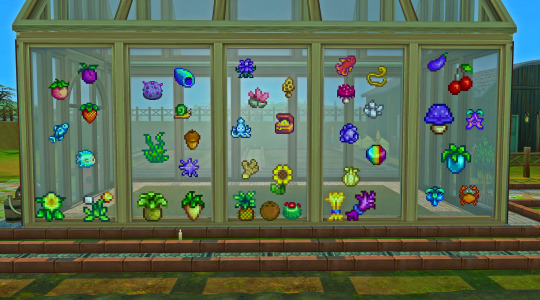
Here's a random in game pic (see more in links provided at top or bottom of post), all decals show through glass too!
🍄Stardew Valley Villagers (yes the bear is a villager I refuse to accept otherwise) portraits
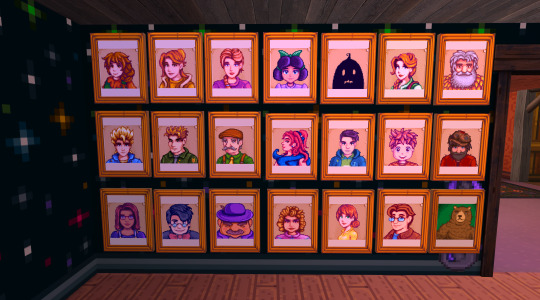
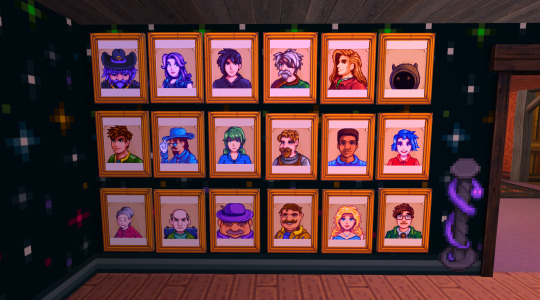
The portraits are the only item with actual dimension, I recoloured a base game framed painting, so these are not flat like the rest of decals. (they look a bit orange but that's just my mood lighting)
🍄Walls and Flooring (indoor and outdoor flooring)
I did all the ones you see here:

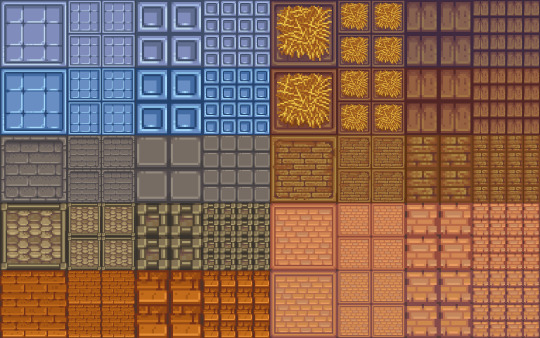

For the floors I made a large and small version of all:
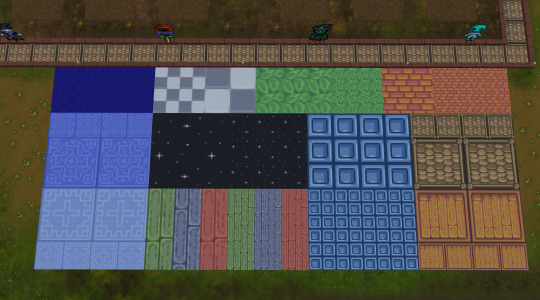
🍄You can see more CC in game pics in my wip post here
Are you sick and tired of those smooth graphics from Sims 4? Do you wish you could replace those pesky curves and detailed HQ textures with nothing but square pixel heaven and flat colours? To be finally rid of all those 3D bump/light effects and replace them with volume-less cardboard cut-out illusion and imagination? Do you want your build/game to look just like Stardew Valley? Or do you simply think that if the sims team are gonna give us low poly and low quality meshes and textures might as well do it properly? Fear not! The solution is here! I made a new Stardew Valley save (why I need yet another save that I'll never have time to complete I don't know) and tried my first build, the recreation of my current (and only) farm. It was ok but I got frustrated at how "Sims 4" everything looked, and checked for stardew valley cc conversions, art, decor but only find people making it using sims 4 stuff, which is probably the most logical thing but not for me! So I made this as there are plenty of game assets from Stardew Valley available online and however tedious and time-consuming resizing the tiniest of pixel art images is to fit Sims 4, it is fairly easy and doable, so I did it. I did skip some items in each category as there are way too many and just did the ones I like, sorry if there was one I didn't include. Also there are some floors in the game or icons that I couldn't find. Some Junimos were taken from the internet but most are individually resized game assets. INFO: all decals in wall deco, all are zero simoleons, and the portraits are 10. You can find my stuff typing "moonbiscuitsims" or "stardew". All have correct colour filter tags and removed "talk to object (insane)" and "can be struck by lightning" (these things annoy me or could cause more distractions for my sims, sorry if you like this though I'm sure there are plenty of objects to talk to/ lightning strikable objects). I don't know if this has an effect. All the portraits are just tagged as brown. All are resizable to your liking. Forgot to mention the floors i think are in wood flooring and outdoor flooring; and I think the walls in panelling. REQUIREMENTS: Nada, nothing. Just base game. (though I did accidentally make one item from a get to work decal by mistake, I remade it to fix it and I've play tested everything, but let me know if something doesn't show up.
PLEASE READ AND RESPECT MY TOU AND DO NOT ❌❌❌: - ❌ Reupload - ❌ Include in sim downloads - ❌ Put behind paywall of any kind no matter what. - ❌ Claim as yours. If you wanna use the texture files to make other different original content that is fine as long as it is different from mine and NO PAYWALLS and no reuploading my stuff. The images are from Stardew Valley, but I spent ages editing every single one to fit the sims, and this took me days to do. All my stuff is free. I don't care about conversions to ts2 or ts3 but NO PAYWALLS and please tag and credit me. If used for screenshots please tag me too, I'd love to see <3 🍄DOWNLOAD (including a pick and choose or a merged file with everything, don't get both) 🍄ALT DOWNLOAD PATREON Enjoy! Happy Simming/Farming
🌵🥥🌴NEW!! Calico Desert Addon🌴🥥🌵
Stardew Valley fav music playlist 🎵🎵🎵
#moonbiscuitsims#moonbiscuitsims4#moonbiscuitsimsstardew#moonbiscuitsimscc#moonbiscuitsimsphotos#mbsdownload#stardew valley#sims 4#the sims 4#ts4#sims cc#sims 4 cc#ts4 cc#stardew valley sims 4#sims 4 stardew valley#sdv#sdv fanart#stardew fanart#stardew#stardew valley fanart#sdv farmer#ts4cc#sims4#sims 4 custom content#the sims 4 custom content
162 notes
·
View notes
Note
hello! i'm not sure if you remember me, a while ago i asked about digital art and if it's possible to do on an ipad or something similar. i was really grateful for your response and i got an ipad over christmas! i didn't realize how expensive the pencils were though and was only able to get one recently. now that i have all of that, i download the first art program i saw (ibispaint x, i don't know how good that is) and feel super overwhelmed by everything, all the tools and brushes and i have no idea where to begin. i know this is a super broad topic, but i don't know if you have any advice for a beginner hoping to become a digital artist? or know of any resources? thank you so much in advance and no worries if this topic is too broad to really get into properly!
Oh hey!! Congrats on getting an iPad! And yeah, shopping for the pens is a big pain in the butt, but I'm glad you finally got it all setup!
So most of the advice I'm gonna give you is very basic, starter advice that can apply to virtually any digital art software, as the vast majority of them are built with the exact same base tools, they just vary in their intended purposes which means they may differ in more advanced settings and what they offer beyond the basics (ex. Photoshop has more colors than Clip Studio because it's built for editing high quality photos whereas Clip Studio is meant to emulate comic art, but Clip Studio offers more in the way of comic-creating tools such as specialized rulers, 3D material support, built-in screentoning, etc. and all of the software available will tend to have different brush engines, meaning it doesn't always 'feel' the same to draw in one software as it does in another).
Your bestest friends:
Layers! This is the biggest pro to going digital, because now you can work with layers! So anything you draw on each layer is preserved and can't touch or affect whatever's on the other ones :3 You can find the layers tab in Ibis Paint X in the bottom right, don't be afraid to make a bunch of them and mess around with what you can do. Play around with the different blending mode settings (in Ibis Paint it's the menu that's labelled 'Normal' in the layers popup) especially Multiply, Color Dodge, and Overlay, as those three are the most commonly used to make coloring more efficient and give your art some extra pop.
Lasso/marquee/magic wand tools! These are basic selection tools that allow you to select an area within the layer you're working on, so that whatever you paint won't travel outside of that area. The Lasso is a free draw tool, the marquee tool is typically 4 sides by default (so squares/rectangles) and the magic wand detects and selects a closed area with one click! (just note that by default it's only on the layer you're on, so if you use it on a layer that has nothing, it will typically select the entire canvas).
Alpha locking! This is a simple button setting you can click to 'lock' the layer you're working on, which basically means that whatever you've drawn on that layer, anything you add can't travel outside of that drawing. So if you want to quickly shade something without going outside the lines, alpha locking is your solution!
Clipping groups/layers! This is a bit more advanced but is basically an even better version of alpha locking that you can use in conjunction with it. Clipping layers are basically additional layers that , when you click the 'clipping group' button, 'attaches' that new layer to the layer that's below it. It performs the same function as the alpha lock by preventing whatever you draw on that layer from travelling outside of it, HOWEVER it comes with the added benefit that it's on an entirely different layer, meaning you can erase and mess with whatever's on that new layer as much as you like and it won't hurt the base layer. It kinda follows the same logic as animation cels !
Masking! Y'know when you're doing a traditional painting, and you put down tape to cover the area so you can paint over it and later remove the tape and everything underneath is untouched? That's basically what masking is! Once you put down a layer mask, using the erase tool on it will 'erase' whatever the mask is applied to, and using the brush will make it magically return! This may sound silly at first, but I find masking is especially helpful if you want to erase something on the layer you're working on without it disappearing forever! It's also really helpful for comic work because you can mask whatever's outside of the panels and voila, nothing you draw will travel outside of those panels!
Stabilization! I don't know how extensive Ibis Paint X is with offering stabilization tools, but many digital art software comes with it and it's a LIFE SAVER for new digital artists adjusting to the feel of digital art. It essentially 'slows down' the output of the ink on the canvas which helps a lot with getting cleaner lines in fewer tries. It's not quite as big of a deal when drawing on iPads because obviously you have more control by default by drawing directly on the screen, but it can still be really helpful when you need to pace your hand ahead of the actual drawing tool to pull cleaner lines!
That's pretty much all I can think of for now! But here are some other commonly asked questions:
1.) There are so many brushes to choose from, which one do I use?
The round brush is small but mighty. Virtually anything can be painted with it, it's simple, but malleable, especially when you start messing around with the hardness and opacity settings. Don't get too lost in the sauce with the brushes that are available to you, it can be very easy to get overwhelmed by all the options and variety. Some artists still work purely with just round brushes, some artists have custom brushes they like to use to speed up their drawing process or achieve certain textures. Play around with them, but don't get too stressed about which one you use because there's no wrong answer, the right brush to use is the one that gets the job done ! <3
2.) What canvas size should I use?
It depends on a variety of factors such as whether or not you're planning to print, where you're going to be posting it, etc. By default I like to work on 8.5 x 11 inch canvases (standard printer paper size) at 350 dpi, which if you want to make that canvas in Ibis Paint X, means you just have to make a canvas with a pixel ratio of 2975 x 3850 pixels! Just note that the lower you go in either pixel count or dpi, the lower the resolution, so it's typically encouraged you work at a minimum of 300 dpi (but you usually don't have to go any higher than 600) to ensure you don't wind up with any blurry low res JPG's/PNG's.
3.) Should I export my final drawing as JPG or PNG?
This is usually just up to personal preference, but like the canvas size, it depends on what you're using the image for. You can always export as both, the biggest difference between them is that PNG is lossless meaning you won't experience image compression like you will with JPG, BUT you're also going to have much larger image sizes. JPG is often fine for any standard posting, PNG is typically recommended if you want to have a drawing with a transparent background for printing (as JPG can't do transparent backgrounds) or if you just want to have a really high res image file for sharing outside of social media sites (as social media sites like FB/IG/etc. will typically compress the hell out of your images anyways)
Here are some other super helpful resources as well if you need some visual and/or audio guides:
Sinix Design - How to Learn Digital Painting (Beginners)
Marc Brunet - The Beginner's Guide to Digital Art
Skynix Art - 50 Digital Art Tips in 5 Minutes
One thing I also like to do is watch speedpaints of digital artists as it can really help pull back the curtain on what they're doing (or at least, it can help you see what they start with which can help you better picture the process of turning a blank canvas into a finished work of art!) And though I don't do it as often, if there's an artist whose work I REALLY like, I'll try and find their actual work files (many bigger artists sell them on their crowdfunding sites/Gumroad/etc.) so that I can actually break the drawings apart layer by layer for the purpose of analysis. Of course, all that is something that you'll grasp better over time as you learn the tools and learn to recognize what artists are doing in their own workflow, so don't worry if you don't glean a whole lot of info from the "big guys" right away, you should always be referencing artists who are higher along the skill ceiling from you but not too high that they're using techniques and tools that are outside of your realm of understanding.
Other than that, just try to have fun, don't stress too much about it, and save often!!! Part of creating art is learning to be at peace with the process, so don't stress too much if it takes you a while to get adjusted to the layouts and tools - at the end of the day, digital art is another medium entirely, so it's not uncommon at all for traditional artists to need a lot of practice to 'switch' to digital, because they both utilize different tools and techniques. Be patient with yourself, always be on the hunt for new resources and guides and references, and don't be afraid to experiment and make mistakes (the best part about digital art? Mistakes don't cost you any paint or materials!)
Good luck!! And congrats again! 🥰
60 notes
·
View notes
Text
My honest reaction to watching S4 of The Umbrella Academy:

WHAT IN TARNATION WAS GOING THROUGH THE WRITERS MINDS????
I thought that s4 would give me answers but instead I have too many questions.
Number 1: WHERE THE FUCK IS MINE AND LUTHER'S WIFE SLOANE
Number 2: Diego getting cheated on why???
Number 3: Allison and Claire's storyline???
Number 4: Why did they move Klaus' powers back to square one when he has the potential to be the most powerful out of all his siblings???
Number 5: *RETACHING NOISES* (I never thought I'd do that by why in the everlovnig fuck would they get him and Lila together just why. WHY???)
Number 6: Not a mention on Brella Ben even though he was by Klaus's side for 15+ years
Number 7: GIMME THE NAMES OF THE PEOPLE WHO DECIDED REGGIE SHOULD GET A FUCKING REDEMPTOIN ARC AND NOT EXPLAIN WHY THE FUCK HE'S AN ALIEN
LOGICAL SOLUTION TO DO AFTER WATCHING TUA S4: RUN TO AO3 DON'T WALK RUN ONLY AO3 CAN SAVE ME NOW 😭😭😭
#tua s4#tua season 4#tua#tua spoilers#hargreeves siblings#umbrella academy#the umbrella academy#ao3 writer#AO3 SAVE ME#PLS#IN GENERAL WTF#like wtf
24 notes
·
View notes
Text
astro notes: daily transits 8/5
Monday, 8/5, presents challenges as Venus forms an uncomfortable quincunx aspect with Pluto, bringing underlying trust issues to the surface. Emotional volatility is further exacerbated by the Leo Moon's square to Uranus in the morning. However, the afternoon brings a shift as the Moon enters Virgo, encouraging a more objective and practical approach. The day's focus turns to remediation with the Moon's conjunctions to Venus and Mercury later in the day.
Key Influences
Venus–Pluto Quincunx:
Trust Issues: This aspect brings to light jealousies, suspicions, and other underlying trust issues in relationships. Emotions run deep, and there may be a tendency to react defensively or possessively.
Leo Moon Square Uranus (8:16 a.m.):
Emotional Volatility: The square between the Leo Moon and Uranus introduces unpredictability and potential emotional outbursts. Breakfast time may be particularly charged with erratic reactions and sudden changes.
Moon Ingress into Virgo (2:17 p.m.):
Objectivity and Practicality: The Moon’s transition into Virgo encourages a more cool-headed and analytical approach. This shift helps to balance the emotional intensity of the morning and promotes practical problem-solving.
Moon Conjunct Venus (4:24 p.m.):
Emotional Remediation: The conjunction of the Moon and Venus in Virgo emphasizes the need for emotional healing and remediation. This aspect supports nurturing and reconciling in relationships, focusing on practical ways to address issues.
Moon Conjunct Mercury (10:19 p.m.):
Clear Communication: The Moon’s conjunction with Mercury later in the evening enhances communication and mental clarity. This aspect is ideal for discussing feelings and finding logical solutions to emotional problems.
Integrating the Influences
Addressing Trust Issues:
Deep Reflection: Use the Venus–Pluto quincunx to delve into underlying trust issues in relationships. Reflect on any jealousies or suspicions that arise and consider their root causes. This aspect encourages deep emotional work to transform and heal trust-related wounds.
Managing Emotional Volatility:
Staying Grounded: With the Leo Moon square Uranus, it’s important to stay grounded and avoid overreacting to sudden emotional shifts. Practice mindfulness and try to remain calm during the morning’s unpredictable energy.
Embracing Objectivity:
Practical Solutions: The Moon’s ingress into Virgo provides an opportunity to approach problems with a clear, analytical mind. Focus on finding practical solutions to emotional issues and work towards creating stability and order.
Healing Relationships:
Nurturing Actions: The Moon conjunct Venus aspect emphasizes the importance of nurturing actions and gestures. Use this time to show care and consideration in relationships, focusing on practical ways to heal and reconcile.
Effective Communication:
Clear Discussions: The Moon’s conjunction with Mercury supports clear and effective communication. Take this opportunity to discuss any emotional issues that have arisen, using logic and reason to find resolutions.
Practical Applications
Morning Reflection:
Identify Triggers: In the morning, take time to identify any emotional triggers related to trust issues. Reflect on how these feelings can be addressed constructively.
Afternoon Objectivity:
Organize and Plan: As the Moon enters Virgo, focus on organizing and planning. Approach problems with a practical mindset and aim to create stability in your environment.
Evening Healing:
Communicate Openly: In the evening, use the energy of the Moon conjunct Venus and Mercury to communicate openly and honestly. Discuss any lingering emotional issues and work towards healing and resolution.
follow for more astro insights like this and head on over to @quenysefields or etsy sensualnoiree to book a session with me :)
#leo#aries#sagittarius#capricorn#virgo#taurus#gemini#aquarius#libra#scorpio#pisces#cancer#sensualnoiree#astro community#astro notes#astro observations#astrology#astro#astro blog#astro posts#astro placements#astrocom#astroblr#astrology chart#astrology fyp#astrology notes#astrology observations#astrology readings#astrology signs#astronotes
10 notes
·
View notes
Text
I am getting flak for my opposition to the north-south rail link and want to clarify: The commuter rail isn’t set up to move you from point A to point B unless point B is Boston. This is because of the economy of scale. Given the practical reality, you should probably drive most short trips in MA unless you live in Boston because very few single town pairs have sufficient gravity to warrant a mass transit solution. This isn’t to say that more or better trains aren’t an overall good, but a system that is overbuilt is going to limit its own ability to effectively serve the public, and cars are, practically speaking, a more autonomous and therefore efficient mode of transport in zones of uniform low density.
When greater Boston has trains and buses that serve significantly more demand than they do now, a north south rail link could be a logical next step, but for right now the corridors that would represent the greatest increase in T Benefit are Everett, chelsea and SoWa/Roxbury/Dorchester and it’s not close.
The tool I have to measure this is a gravity model, which doesn’t give you an absolute number of trips but can give you a comparison between two city pairs.
Population (x) x population (y)/distance^2
Let’s look at some pairs:
Boston-Hingham
Boston population (in thousands): 675
Hingham population (in thousands): 24
Distance: 17 miles
Score: 56
Boston-Concord
Concord population (in thousands): 18
Distance: 18 miles
Score: 37.5
Concord-Hingham
Distance: 31 miles
Score: 0.44
These three pairs show that while only slightly fewer people are likely to travel to boston from concord than hingham, people are 100 times less likely to make a trip from hingham to concord than boston. These are fairly characteristic of commuter rail communities, and transit should reflect that. The commuter rail is organized to get people to boston for a reason. Now, compare that to boston-cambridge or boston-brookline.
Brookline population: 63,000.
Distance: 4 miles
Score: 2,657
Cambridge population: 118,000
Distance: 3 miles
Score: 8,836
These are well connected, peer urban areas with light or heavy rail in proportion to their weight. But now look at Everett:
Population: 49,000
Distance: 4 miles.
Score: 2,064
logically, It should have nearly as much transit as Brookline, which has two and a half legs of the green line. It doesn’t, although the T is fixing this with increased bus connectivity. SoWa/Roxbury/Dorchester is the hardest one to look at here because it’s actually part of boston, meaning I have to change some assumptions about distance and population. I have been up to this point using government center as my boston location, and I’ll pick franklin park as my location for dorchester. I’ll be subtracting the dorchester and roxbury populations from the boston population to get an estimate.
Dorchester pop: 100,000
Roxbury Pop: 60,000
Adjusted Boston Pop: 515,000
Distance: 4.8miles
Score: 3,576
Now, depending on location, these residents might be served by the red or orange lines, but the scores are much higher and there is still nothing like the connectivity of brookline or cambridge. This is a major result of boston’s historic redlining, which I’ve discussed before.
These communities, with scores in the thousands, are desperate for better transit. There are ten thousand trips made on that kind of connection for each trip made between Lowell and Foxborough, and until those communities, who are disproportionately minority, have access to good transit, I won’t worry about the rail link.
There’s a reason this is called a gravity model: it’s an inverse square law, which can be generalized with calculus to cover a whole two dimensional field. Someone who is better at math than me probably already has mapped MA in this way. But the force of gravity between any two communities outside of Worcester-Boston-Springfield-Providence is probably going to be weak, or at least much weaker than the gravity pulling those commuters towards Worcester-Boston-Springfield-Providence.
So with these numbers in mind, who is the rail link for? Which communities are driving the demand for large scale movement of people not to Boston, but past it? Why should the MBTA take on the entire downtown MPA and MASSDot and the Legislature and try to build through the very land government center is on to link north station to south? Why not instead build from Fields Corner to Back Bay and give transit access to one of the most populous transit deserts in the city? Or From Maverick To Malden by way of Chelsea and Everett? It’s just such a low priority for me, and I think it should be for you too.
18 notes
·
View notes
Text
I've been doin skirt math
Or: how to seriously overthink a piece of cloth.
I have complained repeatedly about how the Venn diagram between goth fashion and fair trade/sustainable fashion mostly(1) being two circles which are not touching. But recently-ish I've gotten into sewing and I decided that I will finally take my destiny into my own hands.
I want to make a handkerchief skirt!

It's litcherally just two squares on top of each other with a round hole in it.
How hard could it be?
(1) = I'm sure there must be some, but they are few and far between. I am exaggerating for comedic effect.
Measuring!
I decide to make my skirt roughly 40-60 cm long, starting from my midriff, meaning the distance between the middle and the sides is 40 cm and from the middle to the corners is 60 cm.
Finished, it might look something like this:
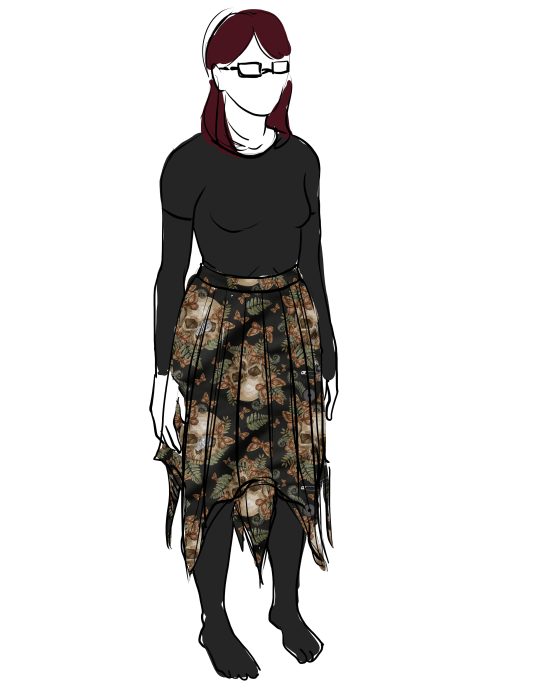
Behold, a rough rendering of the skullchicken's physical form.
Also: did you spot my first logical mistake in planning the cloth? :)
2. Planning
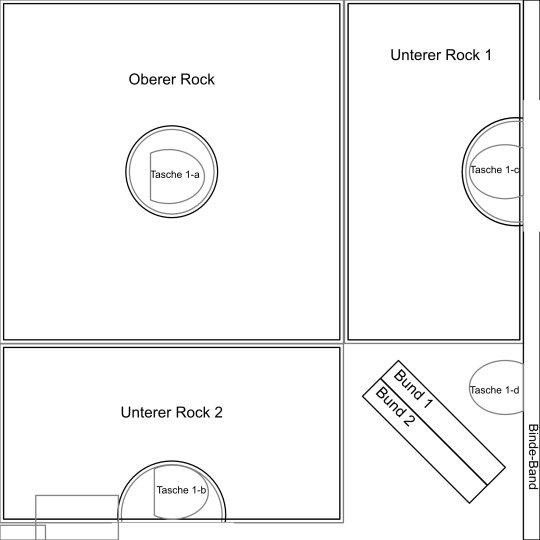
I plan out my pieces on a 150 cm/150 cm square, feeling real clever for dividing the second square like that. The diagonal rectangles are for the opening of the skirt and the long rectangle on the side for the tying band. I even have space for pockets! Amazing!
It's only when I want to draw in where I'll put the pockets in, do I realize that, uh, there isn't any space for them.
Cause you see, if you make a square with a hole in the middle, that means there will be a hole in the middle to subtract from your ultimate skirt length!
... my skirts a mini-skirt :c
Okay, back to the drawing board.
3. Measuring, again.
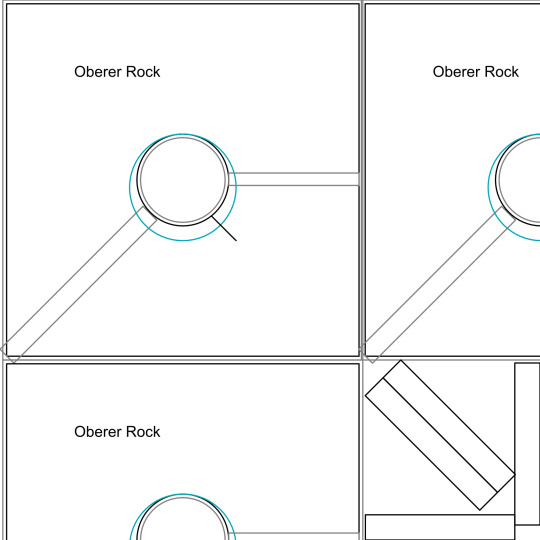
Alright! So I can fit it tightly on a 150 x 150 without the pockets and if I do some trickery with the opening, I miiiight get it all in - ah fuck, forgot about the tying band.
I could just do a 150 cm x 200 cm, but that would net me 50 euro just for the raw materials and a lot of leftovers.
I mean, I guess, but... yeesh.
4. Panels, maybe?
So I figure, hey, how about I try to take out some of the circumference and just sew it out of panels? Let's do a quick sketch on a paper towel and tape it together:

Lookin mighty cute, saltshaker.
The proof of concept works. Sadly though:
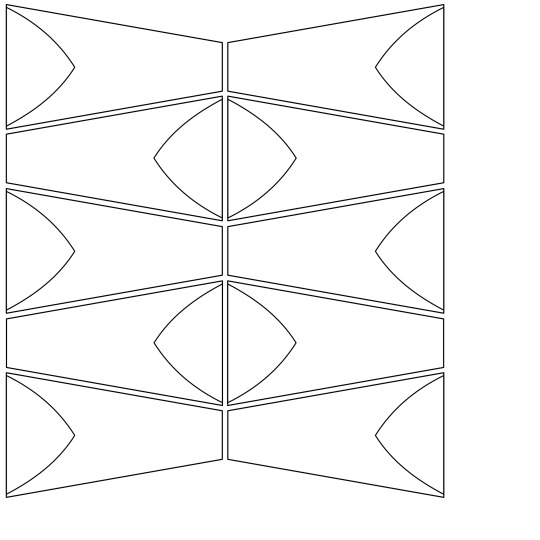
It doesn't save enough cloth to get us back to a 150 cm x 150 cm piece. Darn.
And then it hits me.
5. who needs a hole anyways?
If you think about it, the problem is the hole in the middle. But if you're putting on, say, a cloth with a slit as an opening, it would automatically become a round hole around your hip/midriff.
With a circle skirt, this would be a problem, since the resulting skirt would turn elliptical and crunch up weirdly.
... but a handkerchief-skirt already does that, kinda.
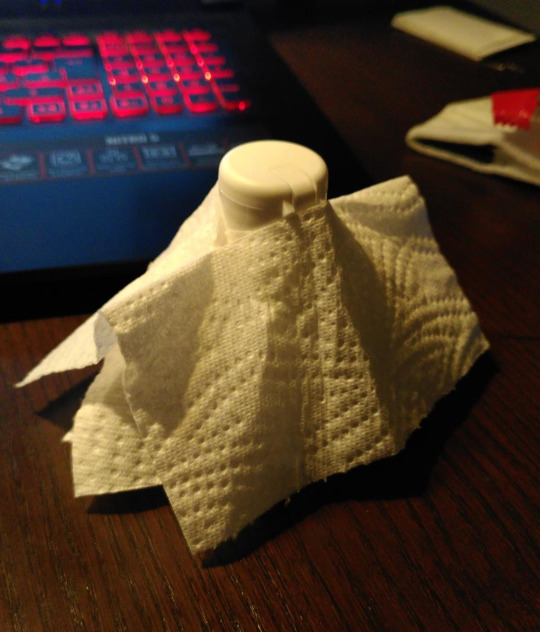
Hmm... not sure if it shakes out.
Pun aside: I'm not sure if I like this, since I can't quite tell if it'll look good when made of cotton instead of a literal handkerchief. It'll probably look symmetrical enough. I'll just have to use rectangles to keep the original measurements of 60 cm at the longest and 40 cm at the shortest.
I will however consult my mom about this, because I have learned that if there seems to be a really neat solution to a problem that no-one uses, that tends to mean there's a good reason not to use it.
... nevermind that I still can't get back to the 150 cm x 150 cm.

I might just have to die one of two deaths (pricey skirt or slightly less pricey shorter skirt *sigh*)
But in any case I feel I have learned a lot, so that's also valuable.
18 notes
·
View notes
Text
If you're good at math:
1. Concept Integration:
Find sums which require in-depth knowledge of more than one mathematical concept to solve. A simple example would be using algebraic expressions as sides of a right angled triangle and finding hypotenuse using Pythagoras theorem and then finding the square root of the polynomial by factorization.
2. Proofs:
Practice writing and understanding mathematical proofs. This helps you develop logical reasoning skills and a deeper understanding of the foundational principles behind mathematical concepts. Very Very important even if it is excluded in the syllabus.
3. Explore Multiple Methods: A continuation of the previous tip; when you learn derivations, you can find short-cuts that work out for you. Or you can explore other methods of solving like graphing two simultaneous linear equations to solve, etc
4. Marry a whiteboard: Seriously, it's so much fun to solve questions on whiteboard. Also, Feynman technique (it's basic so not preaching)
5. Give Olympiads:
Don’t shy away from tackling advanced topics or materials beyond your current coursework. Give Olympiads. They broaden your thinking capacity, and they're reallyyyyyy fun to prepapre for ✨
6. Develop Intuition:
Work on developing mathematical intuition. This involves recognizing patterns, making educated guesses, and estimating solutions before rigorously solving problems. Cannot stress enough on this point. I got a guess correct. It was fill in the integer type questions and the probability of getting an answer right if picked at random was 1/100. Still, went with my gut instict and got it correct.
7. Use Online Resources:
Platforms like Khan Academy, MIT OpenCourseWare, and Coursera offer advanced math courses and lectures that can supplement your learning.
8. Follow me: most important tip 😉😁
#physics#science#study#study aesthetic#study blog#study desk#study hard#study inspiration#study motivation#study notes#math#mathematics#math tutoring
7 notes
·
View notes
Text
Vi Aliens – white visual look Vi and space

It is vertical space shooter. About aliens. Based on science fiction tv-series. Such as Visitors 80s years. So, I am, personally, a fan of style 80s. Vhs tapes. For example.

Space shooters – rather typical game genre in videogames. Age of 80s and 90s, at least. When games were two dimensional. Side view or top down view. All of that, always, was very interesting. Some planet. Or space. Aliens can be very different. Cyborgs. Or some creatures. It was, always, big interest to get to know - what is next. What it will be a next level.
youtube
I remember very well a visual side of Ufo sausages, so white color. So, pure white light. At the background of black space. Ufo sausages - white. Crystal white. And space is black. And, only, stars shines with a white light.

These kind of Ufo sausage were shown very good in tv series Visitors 80s years. There were, even, a fragment when a big Ufo sausage is waving above a city. It was a vey big by its size. And, mainly, design of space ships – interesting theme. Star Gate Sg1, also, good to remember.

So, here it is my design. With impressions after that things. And, so, white color. As a part of design. White or little gray. Few, a little, very a little. Letter V. Latin V. Just like Visitors. But, in my case there is no meaning. Simple visual effect. Latin Vi. Vi Aliens. They are Vi. Should be like this. Science fiction. Action. Space shooter.

I, also, remember some white space in videogame Dead Space. There are scenes with so white color. And space. White corridor and space. Door of the space ship is opening. And, something like, white corridor. Black space above. And, so, white corridor. Something like a tube. But, at the top - it is black space.

And at the low – white as a surface of space ship. Monsters, there are in those places. I remember it very good. So, I decide to make with white color solution, also, a game. So, it is about impression. In part of visual ideas.

Egypt ships. It is theme of science fiction and Egypt. It is, also, can happens. It is Star Gate Sg1. Pyramids are something like flying in space. Maybe even part of ideas goes after Star Wars. Retro episodes. It is, also, interesting sci-fi action. Let`s take this triangle big ship, for example.

New in this vertical shooter. It is bonus system. Several bonus. They have a numbers. Digits. It is so little cubes. With size 15 x 15 pixels. They are flying in space. So, cubes. As Nes games. You pick up one of them and get something interesting. Bonus.

Digit 1 – it restores life. You again with 100 precent of life.
Digit 2 – it is triple laser.
Digit 3 – It is Side C laser.
Picking up these squares, you restore health. Or get upgrade.

And, here we will have 4 bosses. And 1 megaboss. Logic of behavior it will be little another. With compare with previous game (Free Linear Space). Bosses here – it is a big size alien ships. They are big and have their own path on the game screen. Which is on repeat. And, some of them, have a random element. Go to one side or another – random selection. And there are - that moves by certain path. As on rails. So, also, they are exists in this game too.

Basic Pascal version 1.17 "BLOCK" – most newest version. In this version there are 4 new games! Platform Ball, Cabin Pilot, Free Blocker, Free Bee. And even more retro games! It is a pack of retro games with modern versions of Basic and Pascal.
It is now in development new version Basic Pascal pack games. This game will be included in a new version.
Basic Pascal: http://www.dimalink.tv-games.ru/packs/basicpascal/index_eng.html Website: http://www.dimalink.tv-games.ru/home_eng.html Itchio: https://dimalink.itch.io/basic-pascal
#retro game#8 bit#8 bit computers#vintage computers#ms dos#sci fi#science fiction#80s#arcade#space shooter#vertical shooter#shmup#aliens#space#sicence fiction#ufo#visitors#80s tv series#game boss#bonus system#space theme#gamedev#devlog#free basic#retro programming#qbasic#white design#white space#Youtube#visual look
2 notes
·
View notes
Text
CTS B | Week 6 Critical Self-Reflectivity.


In the sixth week of training, our group visited Sim Lim Square to analyze design problems and find ways to improve solutions proposed by previous designeFrs. During this event, we identified one of the pronounced problems in navigating the mall. It consisted in the lack of development of information transfer technologies, such as interactive maps and logical location of stores, as well as in excessive design overload, where a person could quickly get confused.
During this lesson, it occurred to me that the mall did not provide equipment for convenient and understandable movement of people with disabilities (Figure 1).
As a designer, I can say that this problem goes far beyond a single shopping mall. In the digital world, we face similar challenges when creating interfaces. Designers often do not take into account the needs of users with various disabilities, such as visual, hearing, or motor impairments. This leads to the creation of digital products that are not truly inclusive and accessible to all users (Figure 2).
Therefore, after deep reflection and analysis of my professional activity, I came to realize that my previous projects in the field of web design do not fully meet modern accessibility standards for users with disabilities. This moment of self-criticism was an important incentive for me to rethink my design approaches and strive to create more versatile and accessible digital products in the future.
(240 words)
References:
1. University of Washington Web-Page, "Large-Scale Analysis Finds Many Mobile Apps Are Inaccessible", March 1, 2021. https://create.uw.edu/initiatives/large-scale-analysis-finds-many-mobile-apps-are-inaccessible/ (Accessed September 20)
2. WebAIM Web-Page, The WebAIM Million, "The 2024 report on the accessibility of the top 1,000,000 home pages", Mar 28, 2024. https://webaim.org/projects/million/. (Accessed September 20)
3. Pew Research Center Web-Site, "Americans with disabilities less likely than those without to own some digital devices", Andrew Perrin and Sara Atske, Sept 10, 2021. https://www.pewresearch.org/fact-tank/2021/09/10/americans-with-disabilities-less-likely-than-those-without-to-own-some-digital-devices/ (Accessed September 22)
4. Click-Away Pound Web-Site, "The report of the Click-Away Pound Survey 2019", Rick Williams & Steve Brownlow, February 2020. https://clickawaypound.com (Accessed September 22)
2 notes
·
View notes
Text
BRITNEY SPEARS CLONED AND REPLACED?!?!?!
By: Hydra 🐍
Looks like you fell into the trap of conspiracies with that title huh?
I would like to start this discussion with the quote provided by Bridle saying, “We’re all looking at the same skies, but we’re seeing different things.”
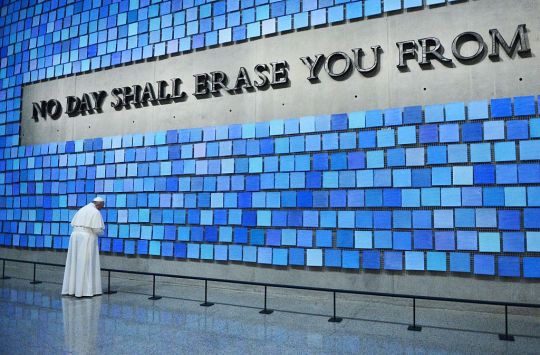
When I first read this, I was immediately transported back to a memory of visiting the 9/11 Memorial Museum in New York City. One of the “exhibits” (I put the word ‘exhibit’ in italics here because it feels wrong to describe these pieces as merely “art” on display for the public) was a wall filled with squares identical in size, yet significantly different in colour. The idea behind the installation is that many different people saw the sky that day, but all viewed it differently (almost exactly what Bridle mentioned in their quote!). Bob may have woke up, looked at the sky and said, “What a nice clear blue sky we have today,” but our perception of the colour blue may not be the same as Bob or anyone else for that matter.
I guess the point I am getting at here is: no matter what we are presented with, we will each perceive (insert item) in a completely different way, unique to our individuality.
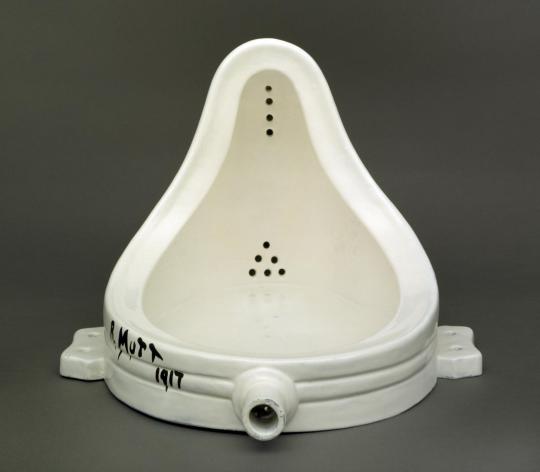
Take Marcel Duchamp’s Fountain for example. Where I may be disgusted that someone has simply turned a urinal on its side, signed it, and called it “art,” someone else may view as beautiful; An everyday item that we don’t think to appreciate. If anything, the piece opened up major discussion of what “art” meant to each individual. Trust me when I say the artists and intellectuals of the world took little time to get their grippers on the “clearest” explanation of Fountain’s purpose and importance.
As an Arts and Humanities student (advanced at that! Thanks SASAH!) that feels the pressure of abiding to the intellectual lifestyle, I can’t help but call upon notable philosopher: Immanuel Kant. Kant has this crazy in depth theory about individual taste… but to spare some time, I will just bring up his critique of the aesthetical judgement. Kant’s critique states, “In order to decide whether anything is beautiful or not, we refer the representation, not by the Understanding to the Object for cognition but, by the Imagination (perhaps in conjunction with the Understanding) to the subject, and its feeling of please or pain” (OSU Library).
So what main stream, controversial, opinionated, subject can we apply all of this to??
CONSPIRACY THEORIES
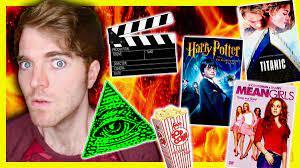
I’m going to bend Kant’s critique to fit my argument and you can’t stop me (!) because guess what? This is my post and you are simply a mere voyeur to my biases hehehehehe
Conspiracies are the ideal beautiful object in this scenario. We spend time listening to them and forming our own opinions on them (whether good or bad), not because of the “logic” provided from them, but because they free our imagination. They allow us to think and discuss beyond popular and imposed upon beliefs (I’m talking societies of control type shizzz), but all though we can express freedom of speech within this, it can lead to dangerous outcomes.
Elise Wang’s TED Talk “Why some conspiracy theories just won’t die,” describes the dangerous outcomes of conspiracy theories. Where one may think they are silly and lighthearted, another may use certain conspiracies to validate a negative opinion (Wang mentions violence and racism) to commit crimes. Do you remember that time a mob invaded the U.S. Capital because they believed that the Democrats were “rigging” the election against Donald Trump? Well the FBI considered that to be an act of domestic terrorism, proving that people act upon violence when applying specific conspiracies.
So what is the solution? Wang suggests that media literacy is the solution that has been proposed, but she does not agree with this. Wang says, “[...] being presented with information that contradicts a firmly held belief is more likely to back fire, making you cling to that belief harder than it is to change your mind” (4:56). When confronted with evidence that challenges someone’s beliefs, they will most likely respond defensively, even if it means ignoring or distorting evidence to fit their prejudgments. Instead Wang’s call of action is: work as an activist. Instead of falling down the rabbit hole of trying to debunk people’s theories (because at the end of the day we have realized media literacy doesn’t work), we must stop giving a platform to radicalizers (14:54). → “[...] proactively protecting the people that conspiracy theories target” (15:02). I agree with Wang in the sense that this has worked in the past. I hate to bring up Trump twice, but he did become a lot more irrelevant once he was put in time out and banned from Twitter.

You may be wondering how we went from talking about a urinal to serious societal issues, and I am also wondering the same…. I guess I am leaning into my yapper characteristics. Anyway’s with all this said, I hope Wang’s solution won’t prevent me from being provided with a good ole’ video about how Chuck E. Cheese reuses old pizza…
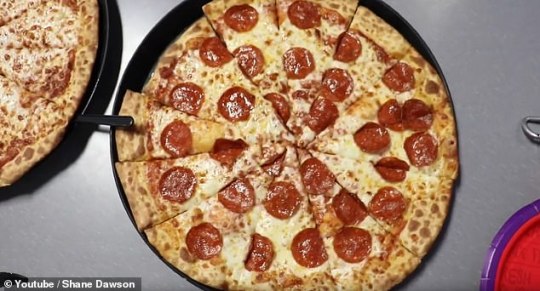
2 notes
·
View notes
Text
ah, really liked Meta Knight from today's Confounding Calendar 2023 drop! it's another one of those puzzles that seems like it'll just be a trial-and-error solve until you start coming up with a plan.
you can try it here, then i'll explain stuff in the rest of the post

so the idea is that the positions of the green boxes determine which squares you can move the green boxes to. you can play around with it some and realize some key details, like how if you ever have a situation where there's no boxes on any given side or corner of the puzzle, then the boxes can never be moved in that direction ever again, or how if you get all of the boxes in positions with certain symmetries, then you can get some even/odd parity or even some hexagonal-shaped parity which is super wild lol

the fun bit that i ended up noticing which leads to a solution is that there's exactly one way to order the boxes such that each one's position lets you move the next one in the chain into the required spot, looks something like this:

so if you had the boxes placed on these numbers, then the 3 box lets you complete the 4 box, the 2 box lets you complete the 3 box, the 1 box lets you complete the 2 box, and the 1 box completes itself.
the solution doesn't pan out exactly like that, but once i had this configuration in mind, i started setting it up and the solve happened pretty quickly afterward.
edit: actually i lied! the solution does work exactly like that and you can set it up in exactly 4 moves, so you can solve the whole thing in only 8 moves. i noticed that while i was trying to fall asleep for the night. you know it's a good puzzle when you're still thinking about it while trying to fall asleep for the night
i found that logic pretty enjoyable! thanks beekie
3 notes
·
View notes
Text
Innovative Mold & Preforming Design for FRP Pultrusion Manufacturing
At Hengshui Hongwo, we specialize in precision engineering of pultrusion molds and preforming systems for diverse FRP profiles, including FRP Rod, FRP Pultruded Round Tube, FRP Square Tube, FRP I Beam, and FRP U Channel. Our proprietary technologies ensure optimal structural integrity and dimensional accuracy across all product lines.
Core Design Principles
Preforming

Optimization
Multi-stage preforming systems withwear-resistant fiber-guiding grooves andchamfered yarn ports) enable seamless transition from flat reinforcement mats to complex profiles like FRP Angle and FRP Rectangular Tube.
Transition zones (0.5–1.5m) progressively align fibers to minimize stress concentration.
Mold Engineering Excellence
Forged mold steel undergoes quenching and nitriding to achieve >60 HRC hardness, critical for high-wear components in FRP Pultruded Round Tube production.
CNC-machined cavities ensure ±0.1mm tolerance for FRP Square Tube and FRP I Beam cross-sections.
Material-Specific Solutions
FRP U Channel: Layered fiber orientation with UV-resistant resin infusion prevents delamination under cyclic loading.
FRP Rod: Pre-compacted roving bundles reduce voids by 30% compared to conventional designs.
Quality Assurance
Our ISO-certified process integrates real-time load-bearing tests for FRP Angle and automated thickness monitoring for FRP Rectangular Tube, ensuring compliance with ASTM standards.
By synergizing advanced preforming logic with hardened mold systems, we deliver FRP profiles that outperform steel in corrosion resistance (5–8× lifespan) while maintaining 1/4 weight. Partner with us to optimize your structural applications with engineered pultrusion solutions.
0 notes
Text
File Naming Conventions for Edited Ecommerce Images

In the world of eCommerce, high-quality product images are essential — but how you organize and name those images matters just as much as how they look.
Whether you're managing hundreds or thousands of product photos, consistent file naming conventions can save time, improve SEO, and streamline your workflow.
This is especially crucial for platforms like Shopify, where clean and logical file names help ensure smooth uploads and optimized product listings.
Shopify Product Image Sizes are also worth considering during the image editing and export phase to maintain quality and performance.
At Clipping Way, we understand the importance of keeping your images professional, organized, and search engine friendly.
That’s why, alongside offering clipping path services, we also guide clients on how to structure their digital assets effectively.
Why File Naming Matters in Ecommerce
When your online store hosts thousands of images, random filenames like IMG_3245.jpg or DSC10002.png don't just look messy — they become difficult to manage, track, or identify.
Worse, these filenames contribute nothing to your SEO strategy.
Here’s why file naming conventions are crucial for eCommerce success:
Improved SEO: Search engines like Google crawl image filenames. A name like black-leather-wallet-men.jpg provides more SEO value than IMG12456.jpg.
Faster Workflow: Editing, uploading, replacing, or linking files becomes easier with clear naming.
Reduced Errors: Avoid mistakenly overwriting files or misplacing assets during bulk uploads or edits.
Professionalism: Clean filenames reflect brand professionalism and organization.
Best Practices for Naming Edited Ecommerce Images
1. Use Descriptive Keywords
Think about what your customer would type into Google. Instead of img123.jpg, use blue-cotton-tshirt-mens.jpg. This helps in both search rankings and product management.
2. Keep It Lowercase and Use Hyphens
Avoid spaces and special characters. Stick to lowercase and separate words with hyphens, like this: ✅ organic-linen-throw-pillow.jpg ❌ Organic Linen Throw Pillow.JPG
3. Include Product Identifiers
If your store uses SKU numbers or product codes, including them helps link images directly to product listings or inventory systems. Example: sku2384-red-leather-backpack.jpg
4. Add Versioning When Needed
When editing multiple versions (for different angles or zoom levels), use suffixes like:
front
side
zoom Example: sku2384-red-leather-backpack-front.jpg
5. Be Consistent Across the Board
File naming is only effective if it’s consistent. Set a format and stick to it across all images and categories. You might follow a structure like: [sku]-[color]-[product-name]-[angle].jpg
Bonus Tips: Shopify-Friendly Naming & Sizes
Shopify is one of the most popular eCommerce platforms and has its own guidelines.
While it doesn’t restrict file names, it prefers SEO-friendly names and optimized image sizes for fast load times. For best results:
Stick with names under 255 characters.
Compress your images without losing quality.
Recommended Shopify image size: 2048 x 2048 pixels for square images.
Our team at Clipping Way ensures every edited image is optimized to meet Shopify Product Image Sizes and is properly named according to your store's standards.
Benefits of Letting Professionals Handle Image Naming
At Clipping Way, we don’t just crop or retouch images. We provide a complete image editing solution — including smart file naming that fits your brand, SKU system, and platform (Shopify, Amazon, eBay, etc.). You can enjoy:
SEO-optimized filenames
Clean, organized file structures
Platform-specific naming adjustments
Bulk naming for large inventories
Lower cost packages with Free Trial & Get Quotation options
We pride ourselves on affordable pricing, quick delivery, and a 100% satisfaction guarantee.

Frequently Asked Questions
1. Why is image file naming important for SEO?
A: Search engines use image filenames as one of the factors to rank pages. Descriptive filenames increase the chance your product will show up in image search results.
2. What’s the best format for Shopify image names?
A: Use lowercase letters, hyphens between words, and relevant keywords. Avoid spaces and special characters.
3. Can Clipping Way help rename existing images?
A: Absolutely! We offer bulk renaming services as part of our image editing solutions. Whether you’re reorganizing or launching a new store, we’ve got you covered.
4. How can I test your image editing service?
A: You can request a Free Trial directly on our website. Just upload your sample image and we’ll show you the Clipping Way difference.
5. Is it possible to get a quote before ordering?
A: Yes, our Get Quotation feature allows you to receive an accurate price before you commit — no surprises.
Conclusion
Clean, strategic file naming isn’t just a backend task — it’s a foundational part of your eCommerce success.
With platforms like Shopify and search engines relying on smart naming for performance and discovery, investing time in proper file naming is a must.
At Clipping Way, we not only deliver pixel-perfect edited images, but we also help ensure every file is named correctly, consistently, and professionally.
From free trials to low-cost packages, we make it easy for online store owners to succeed without stress.
0 notes
Text
How to distract yourself from negative experiences and do what is really important to you?

There are different circumstances in life, and not all of them have a positive effect on a person's emotional mood. Anxiety, depression, and chronic stress can shake physical health.
They make it difficult to navigate the situation, to get out of the crisis with minimal losses. The inner world needs to be stabilized first of all. How can you help yourself to find balance, regardless of external events?
The first step: is awareness of excessive psychological stress
The beginning of solving any problem is to pay attention to it, to understand that it exists. Constant stress and bad mood are not the norms.
All people have negative experiences. They should not be suppressed – it is useless and harmful. It is more logical to give them a way out through safe physical actions. The stream of consciousness is also rarely calm and clear, especially against the background of nervous tension or depression. Experiences give rise to anxious thoughts, and the future is seen in a gloomy light – the state of mind worsens.
Having discovered symptoms such as chronic anxiety, apathy, or obsessive fears, you need to understand the awareness of your condition.
The second step: cleansing your emotional state
There are three effective exercises to release negative energy:
#1. The scream
All you need is a soundproofed room or a deserted place in nature: a forest or a field.
#2. Interaction with water
Any liquid, especially water, has the ability to absorb and store information. Therefore, the most important point here is the flow. A shower or a river will do, a basin or a standing pond will not. You need to focus on the subject of your anxiety, being close to running water.
The effect will increase if you formulate your problems and speak out loud. The current will carry away negative emotions. You will be surprised how much easier it will become in a few minutes if you do the exercise seriously.
#3. Tactile contact with a living tree
For the sake of this exercise, you do not have to go far: any park or square near the house will do. Task: find a tree that you like the beauty of the crown, the texture of the bark, or something else, and embrace it. Yes, it's that simple. Instead of accumulated negative energy, you will receive an influx of natural forces. Don't be shy – it's worth it.
#4. A look at the situation and prospects
Divide a sheet of a notebook or notebook into two columns. Fill the first one with obsessive reasons for fear. (For example, loss of a source of income, illness, difficulties with housing). In the second column, state how great is the risk of a particular situation. What makes you afraid – real prerequisites or abstract anxiety?
Write at least ten ways out of a possible crisis. Let your imagination run wild, the subconscious finds non-standard solutions when it is not restrained. Next, list what you would need to implement in each scenario. What additional knowledge, skills, contacts, and opportunities, and in what ways you could get them? And it will turn out that out of ten solutions to the problem, at least one will be feasible.
The third step: filling with energy, and restoring the internal resource
Breathing – its depth and rhythm – is extremely important for the nervous system. Therefore, breathing exercises should not be neglected.
1. Soothing: the left nostril closes, inhales,s and exhales through the right, then it closes, breathing occurs through the left – and so on in turn.
2. Setting the rhythm: inhale at the count of "one", the breath is delayed at "two", exhale at "three", and pause again at "four".
Another way to accumulate positive energy is meditation, that is, sessions of increased awareness. Observation of the flight of an ordinary maple leaf. You can focus on your feelings during the usual actions of cooking, and ironing. All this helps not to get scattered, but to concentrate on the moment here and now.
To distract yourself from negative experiences and do what is really important is your goal. Not necessarily work, but any activity that captures and fills life with meaning. This is what you need to focus on.
Allow yourself to experience happiness – let it become a natural state.
https://elenasunshinemagazine.com/healthy/how-to-distract-yourself-from-negative-experiences-and-do-what-is-really-important-to-you/
0 notes
Text
Learning Design Patterns in Programming

Design patterns are reusable solutions to common software design problems. Whether you're a beginner or an experienced developer, learning design patterns can greatly improve your ability to write clean, scalable, and maintainable code. This post introduces the concept of design patterns, why they're important, and how you can start using them effectively in your projects.
What Are Design Patterns?
A design pattern is a proven way to solve a specific problem in software design. These patterns are not code snippets but templates or best practices that guide developers in structuring their programs.
Why Use Design Patterns?
Code Reusability: Promotes the use of reusable solutions.
Scalability: Makes it easier to scale applications.
Maintainability: Leads to cleaner and more organized code.
Team Collaboration: Helps teams follow a shared vocabulary and approach.
Problem Solving: Speeds up decision-making by providing tried-and-tested approaches.
Categories of Design Patterns
Creational Patterns: Focus on object creation mechanisms (e.g., Singleton, Factory).
Structural Patterns: Deal with object composition (e.g., Adapter, Decorator).
Behavioral Patterns: Manage communication and behavior (e.g., Observer, Strategy).
Common Design Patterns Explained
1. Singleton Pattern
Ensures a class has only one instance and provides a global access point to it.// Singleton in Java public class Database { private static Database instance; private Database() {} public static Database getInstance() { if (instance == null) { instance = new Database(); } return instance; } }
2. Factory Pattern
Creates objects without exposing the instantiation logic to the client.// Factory Example in Python class ShapeFactory: def get_shape(self, type): if type == 'circle': return Circle() elif type == 'square': return Square()
3. Observer Pattern
Defines a one-to-many dependency so that when one object changes state, all its dependents are notified.
4. Strategy Pattern
Allows algorithms to be selected at runtime by defining a family of interchangeable behaviors.
5. Decorator Pattern
Adds new functionality to objects dynamically without changing their structure.
Best Practices for Learning Design Patterns
Start with the basics: Singleton, Factory, and Observer.
Understand the problem each pattern solves.
Use real-world examples to grasp each pattern.
Refactor your existing code using design patterns where applicable.
Don't force patterns—use them where they naturally fit.
Resources for Learning
Refactoring Guru – Visual and code-based examples.
SourceMaking – Classic explanations.
Java Design Patterns GitHub Repo
Book: Design Patterns: Elements of Reusable Object-Oriented Software by the "Gang of Four".
Conclusion
Design patterns are a powerful tool for developers at all levels. They provide a structured approach to solving common programming problems and help build applications that are easier to manage and extend. Start small, practice often, and soon you'll be writing better code with confidence.
0 notes
Text
It’s 8 April 2025. I’m very tired. I think it’s related to achieving new levels across a variety of things, tangible and intangible. Example: I started to type something about how to explain generating the physical, but it mutated rapidly until it became the wrapping of 1Space and 0Space. That encloses pattern, which is energy, which is D3-4 existence.
Note that I finally got that S5 isn’t solvable because it’s subgroup A5 is simple, and though S5 is order 120 and A5 is order 60, so there’s a 2 count which is why Z/Z2, that indexing isn’t enough: the subgroup must be solvable, meaning it decomposes, but it doesn’t. The point: 2 levels. That’s the idea in CM28 and CM2.8, that CM28 entails and invokes the ambiguity of Pathways either or, along with then a potential for and, and reduced by Mag10 means the scaling of gsProcess in Togs. Fluency is coming along.
But I have to say my entire midsection is worn because I was able to get on the bike, meaning I was able to get my legs spinning 100+ while laying my upper body low for wind position. That really punches up into the abdomen. I was able to do that in various hand and arm positions. One effect was immediate: I prefer going up steps 2 at a time, but now the method has shifted even farther forward but so the upper, lead foot is landing on its toe with the weight over it, which means the entire body structure has shifted up, which requires that same isolation of the legs with the upper contracted into a ‘springy’ position, meaning it isn’t locked in place but works with the leg movements. As in, I was able to do twists while in this position, which took some concentration to keep smooth, with the rpm hum remaining at a high enough pitch.
That and the last 2 days have seen compression into the space around and behind or into my eyes like I’ve never experienced. Very intense and I have soreness across the front of my face.
I have always thought that we generated a good reason why the quintic can’t be solved. Let’s see. My guess to begin is that I never managed to look at the issue closely enough to be certain, and I was relying on intuition which we’ve never worked through. I now remember working through aspects using gsSheets and the logic of D-structure. So we begin with D2, which we see as 2 Ends and thus the potential of their relationship expands to IC by the construction of a 1-0Segment. We can see the relationship as expanding the Between of the 1-0Segment orthogonally, which constructs to a square in ideal, but is obviously rather flexible.
This is mirrored in the structure of general solutions relying on quadratics: the cubic solution generates a quadratic whose roots are the cubes you seek, while the quartic is cut in two, with both processes involving an intermediate stage or 2.
This stuff is finally making sense, which suggests it should translate into something interesting. Like in the simplest model terms, the way we thought about the quintic is using the little hats. That way you can see the extra gsProcess as the choice of little hat before you reach D4 and the image of a gs. The same logic applies to higher dimensions, like the sextic: in the cases where it breaks down, it’s solvable because you can construct that quadratic.
I had to take a break. And now I’m vegetating. I knew I’d eventually get this material, but this was hard to accept. Of course we had it correct the first time, but knowing that took a lot of effort.
0 notes